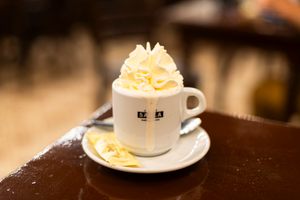
When the Spanish encountered cacao in Mexico in the early 16th century, Barcelona became an important transit point for the ingredient when it arrived in Europe. But xocolata, as processed chocolate is known in Catalan, didn’t become mainstream in the city until a couple hundred years later.
Eventually, the ingredient came to be included in dishes both savory and sweet, and Barcelona gained a strong reputation for both its chocolate consumption and production. In particular, Carrer Petritxol, in the city’s Gothic Quarter, became home to several chocolate shops, lending the narrow lane the nickname of “Chocolate Street,” a history described via tile murals that line it.
Arguably the most famous of these is Granja Dulcinea, opened in 1941. Generations of locals have come here to drink xocolata a la tassa, Catalan-style hot chocolate, dark and rich—almost chocolate mousse-like—but milkier and less thick than elsewhere in Spain. If this isn’t enough, opt for the decadent suís, the “Swiss,” hot chocolate topped with a mountain of rich whipped cream, or you can pair your mug with the dense, sugar-dusted churros—perfect for dipping.
The interior is charmingly decked out in dark woods, there’s a fireplace and a small upper balcony, and all the servers are men. They also serve a variety of baked goods including ensaïmadas, a pastry of Sephardic Jewish origin from Mallorca that’s common in Barcelona.

Post a Comment